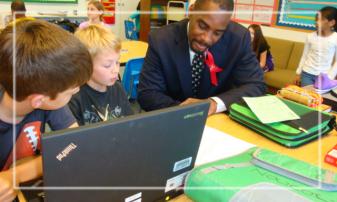How Technology Can Encourage Student Collaboration
Common Sense Filed by Sarah Jackson in In the Classroom, Research & Studies 12/16/2013
Published: December 17, 2013

Photo: DoDEA
Today’s employers say the capacity to collaborate to solve problems is going to be even more important for tomorrow’s workers than content knowledge. And a recent study shows employers are looking for people who can work effectively in teams.
Forward-thinking teachers are using technology to promote teamwork and collaborative projects, linking their students to classrooms across the globe. Yet building students’ collaborative skills is tough in traditional classrooms, where a teacher stands at the front of rows of students isolated by desks.
Thoughtful use of technology can break this traditional paradigm, but educational technology leader Alan November cautions that the first step is to change old mindsets, not to provide new gadgets.
“Sadly, most schools use the internet only to find information,” November observed four years ago in a video reflection about the myths and opportunities of technology in the classroom. By contrast, his work with schools encourages “a shift of control from the teacher at the center to the network of children who are helping one another learn.”
Check out “Myths and Opportunities: Technology in the Classroom by Alan November” by November Learning on Vimeo.
The video is available for your viewing pleasure at “Myths and Opportunities: Technology in the Classroom by Alan November
Teachers who are on the forefront of this shift rave about the difference it has made for their students. “Students who once sat in the back of the room and didn’t want to speak up or be part of the lesson now are excited to get online and share what they’re learning. They want to teach others and they feel like their voice matters,” said Jill Barnes, a 7th-grade teacher at Grafton Middle School in York County, Virginia.
Barnes is one of more than 400 teachers participating in a study sponsored by Pearson, Digital Promise, the National Network of State Teachers of the Year, and the University of San Diego. Teachers -- who started the process across the full spectrum of comfort with digital resources, from novices to seasoned pros -- received training in digital teaching strategies and self-monitored their use of technology in the classroom.
The theory behind the move to use technology to expand collaboration relies on both social science and recent developments in cognitive science that help us better understand the learning process. In 2004, the National Academy of Sciences published the seminal book How People Learn, which integrates cognitive science with recommended learning environments. For example, a significant research base exists to show that experts monitor their own understanding carefully as they tackle a tough math problem or read complex text, and that children can be taught metacognitive strategies to help them notice what they do and do not understand. These metacognitive strategies can be taught first by a teacher modeling her own internal thought process while working a problem or reading, and then giving students ample chance to practice and discuss the strategies. Ideally, this work occurs in an intellectual community where students ask each other clarifying questions and work together to solve problems.
How can teachers use technology to create such environments? One hot trend is “flipped” classrooms, where students absorb material by reading or watching a video prior to class. Teachers can create their own video lectures or use educational videos from sites like TED-ed and Khan Academy. Students then spend class time engaged in projects that require them to refine their understanding of the material and apply what they have learned.
Whether you formally flip your classroom or not, you can use popular online tools to promote teamwork and student collaboration. Figment, an online community of writers, provides both collaborative writing spaces through its groups and a place to publish finished work. “I would sign up for Figment to create a collaborative writing space for kids interested in using it during class,” noted a Virginia teacher reviewing the site for Graphite. “I also think Figment’s guidelines offer a useful starting point for class discussions of digital citizenship, participation, and fair use.”
Classroom pen pals take on a fresh look at ePals, where students from more than 200 countries not only send each other email (via a secure system that teachers can monitor), they can work together on projects and video chat. Teachers value the opportunities for students to practice language, learn more about culture and geography, and tackle projects as simple as swapping recipes or as complex as creating a wiki describing the musical instruments of multiple countries. As we wrote: “Creating a safe space for kids across the world to communicate and collaborate, ePals is a really neat idea that works.”
How do you use digital tools in your classroom to encourage collaboration?